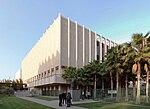Park La Brea, Los Angeles
AC with 0 elementsApartment buildings in Los AngelesCentral Los AngelesMid-Wilshire, Los AngelesNeighborhoods in Los Angeles ... and 2 more
Planned communities in CaliforniaWestside (Los Angeles County)

Park La Brea (Spanish: La Brea—"The tar", after the nearby La Brea Tar Pits) is a sprawling apartment community in the Miracle Mile District of Los Angeles, California. With 4,255 units located in eighteen 13-story towers and thirty-one two-story "garden apartment buildings", it is the largest housing development in the U.S. west of the Mississippi River. It sits on 160 acres (0.65 km2) of land with numerous lawns.
Excerpt from the Wikipedia article Park La Brea, Los Angeles (License: CC BY-SA 3.0, Authors, Images).Park La Brea, Los Angeles
South Fuller Avenue, Los Angeles Mid-Wilshire
Geographical coordinates (GPS) Address Nearby Places Show on map
Geographical coordinates (GPS)
| Latitude | Longitude |
|---|---|
| N 34.06583 ° | E -118.35417 ° |
Address
South Fuller Avenue 512
90036 Los Angeles, Mid-Wilshire
California, United States
Open on Google Maps









